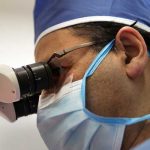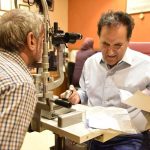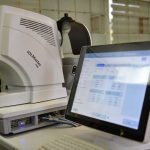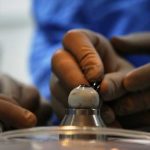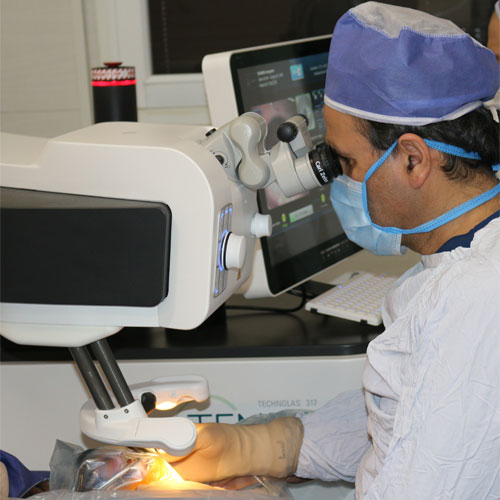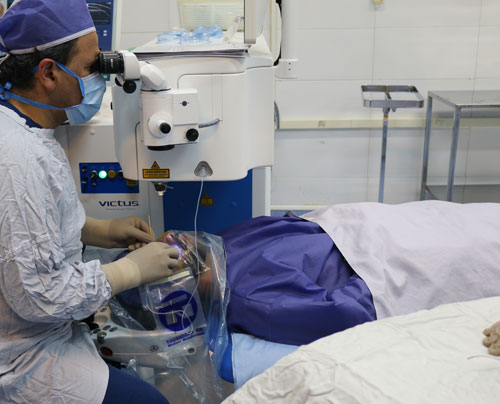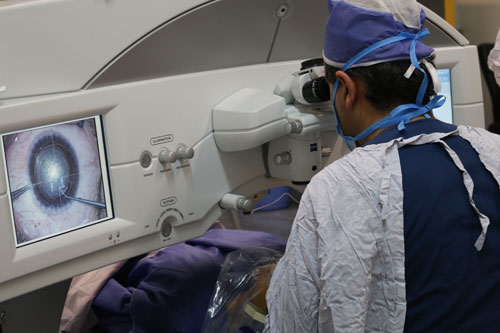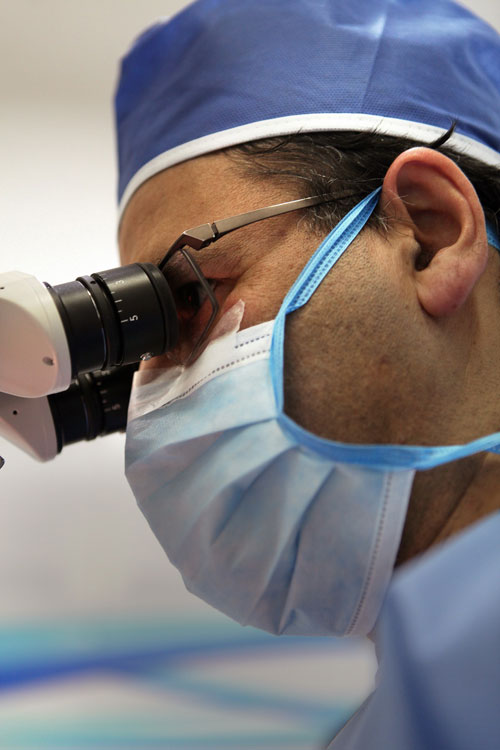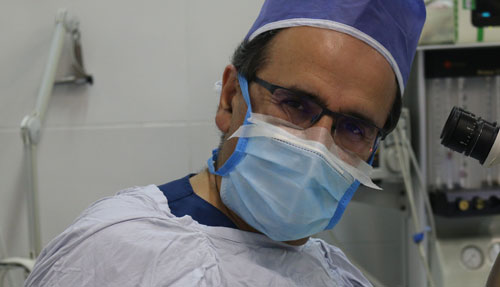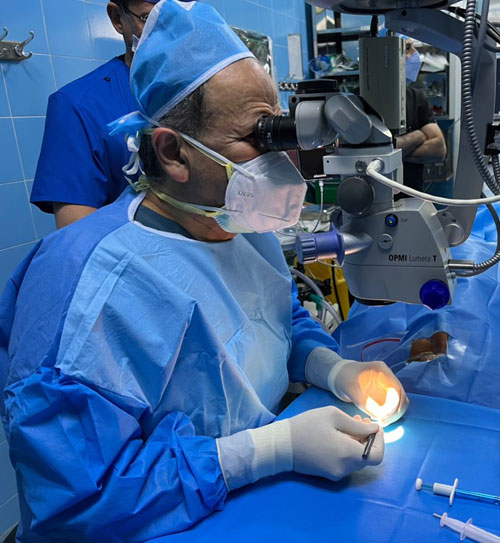Correction of Refractive Errors
PRK
Photorefractive keratectomy (PRK) is a type of laser eye surgery for correcting refractive errors including myopia, hyperopia, and astigmatism. It is an outpatient and very fast procedure which normally takes less than 10 minutes for both eyes.
During this surgical procedure, the eye gets numb with anesthetic drops, and the eyelid holder is placed on the eye to keep it open. Then, the outer layer of the cornea, epithelium, is removed and the cornea is reshaped using an excimer laser in order to treat the refractive error. Finally, the surgeon puts a contact lens over the eye which works as a bandage.
You may not be eligible for PRK surgery if you are younger than 18 years, your vision prescription has changed for at least 12 months before the surgery, you have glaucoma, cataracts, or similar eye conditions, you have Intraocular inflammation, you have uncontrolled diabetes, or you are pregnant or breastfeeding.
Although PRK surgery is a safe and effective procedure, it may have some side effects including scarring, infection, cloudiness of the cornea or corneal haze, a halo effect around lights, light sensitivity, hazy vision, double vision, and severe or permanent dry eye.
After the surgery, you should wear sunglasses outside as long as your doctor instructed. You may feel pain and irritation in your eye for about two or three days after the surgery. The contact lens will be removed from your eye within seven days after the surgery. It normally takes 3-6 months to find your full recovery.
Femto Lasik
Femtosecond-assisted (Femto) laser in-situ keratomileusis is a type of laser surgery for resolving refractive errors including hyperopia (farsightedness), myopia (nearsightedness), and astigmatism. It is an outpatient and effective procedure.
During the surgery, an ultra-fast femtosecond laser is used to create the corneal flap and then by lifting the small flap, an excimer laser is applied in order to reshape the cornea and correct the refractive error. After the surgery, the corneal flap is replaced to its own position to be healed without any suture in it.
Eligible candidates for Femto Lasik surgery are those who are 18 years or older, are not pregnant or breastfeeding, have not thin or uneven cornea, or eye conditions such as cataracts or glaucoma, and have stable vision prescription for at least 12 months before the surgery.
As with any surgical procedure, Femto Lasik may come with some risks or side effects like light sensitivity, halos or glare around lights, hazy or blurred vision, or dry eye which most of them usually last for a short period after the surgery and are not permanent.
After the surgery, you may feel pain or discomfort in the first day or two, however, your eyes will probably heal very quickly.
SMILE
ReLEx SMILE stands for Refractive Lenticule Extraction Small Incision Lenticule Extraction is the latest innovation of laser refractive surgery for correcting refractive errors including myopia and astigmatism. SMILE technique is the further development of the Femto LASIK surgery avoiding the complications of the corneal flap.
During the surgery, the femtosecond laser is applied to create a small, lens-shaped tissue within the cornea called Lenticule. Then the same laser is used to create a small incision for extraction of the lenticule and reshaping the cornea.
The minimum age limit for this surgery is 18 years. Pregnant or breastfeeding women or people with hyperopia are not eligible for this type of laser refractive surgery.
SMILE is a less invasive refractive surgery with a minor risk of dry eye, however, you might experience light sensitivity, blurred vision, or poor night vision after surgery which all are temporary.
Trans PRK
Trans PRK stands for Transepithelial PhotoRefractive Keratectomy is a type of laser refractive surgery for correcting refractive errors. What makes this technique different from PRK is that it has no physical touching for reshaping the cornea. Instead, all steps of the surgery including ablation of the surface cells and reshaping the cornea are done by laser. Thus it is quicker and more accurate than PRK surgery with fewer complications and side effects.
Supracor
When you are young, the crystalline lens inside the eye is very flexible like jelly. As you get older, the crystalline lens becomes harder and resists changing. Thus the point of focus gets further away leading to reading problems. Supracor is a quick, painless, and outpatient laser refractive surgery for correcting presbyopia.
During the surgery, the femtosecond laser is used to create a very thin flap precisely and then an excimer laser is applied to sculpt the cornea in order to provide the near vision focus and improve visual quality.
After the surgery, the distance vision may be blurred, but it improves with time while the near vision is excellent right away. In addition, patients may see halos at night which is temporary.
Intraocular Lens
The intraocular lens is made of clear plastic and coated with a special material to protect the eye from the harmful ultraviolet (UV) rays of the sun. The IOLs have different focusing powers just like eyeglasses or contact lenses and the ophthalmologist sets the appropriate focusing power for your eye based on the length of your eye and the curve of your cornea.
There are different types of IOL including:
Monofocal IOL: This is the most common type of lens used in cataract surgery with one focusing distance. It can be set to focus for either clear near vision, or distance vision. If it is set for clear distance vision, you should wear eyeglasses for reading and close works.
Multifocal IOL: this type of IOL has different focusing powers and can provide both distance and near focus at the same time.
Accommodating IOL: These IOLs are flexible and act more like your natural lens and allow focusing at different distances.
Toric IOL: The Toric lens is a type of monofocal IOL that is designed to correct astigmatism.
There are some uncommon complications after cataract surgery which mostly are temporary and treatable including inflammation, bleeding, infection, drooping eyelids, dislocation of artificial lens, retinal detachment, secondary cataract, glaucoma, double or dim vision, impaired night vision, or loss of vision.



